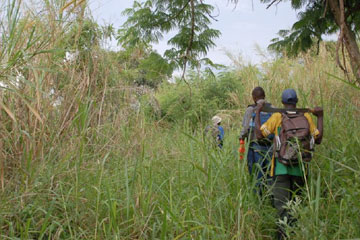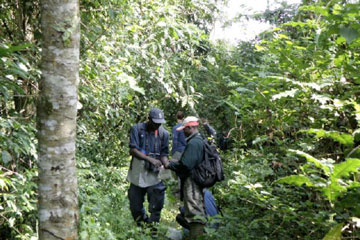Keeping fire at bay could be key to reforesting abandoned land in the tropics, according to a new study in mongabay.com’s open access journal Tropical Conservation Science. Measuring the recovery of regenerating forests in Kibale National Park in Uganda, the study found that suppressing fire allowed the forest to come back over a period of decades. Given the role rainforests play in sequestering carbon and safeguarding biodiversity, the study argues that reforesting abandoned land in the tropics should be a global policy and controlling fire may be an simple and largely inexpensive method to achieve the goal.
Unlike in temperate forests, fire is not a common occurrence in tropical forests. However, human-started fires have become commonplace in many tropical regions, destroying forests and keeping them from returning. The paper states that when rainforests are destroyed and then land subsequently abandoned, the area sometimes turns into grasslands instead of returning to its original state as forest.
  Top: an area of Kibale National Park, Uganda where forest was cleared for agricultural use and then has not regenerated to forest since it is frequently burnt. Bottom: a typical area of young regenerating forest that has been protected from fire. |
“These grasses increase the likelihood of fire, which inhibits the establishment of woody vegetation and arrests forest regeneration,” the authors explain, posing a particular problem for reforestation efforts.
To study how rainforests regenerate when free from fire, researchers measured biomass at two different sites in Kibale National that had once been forested.
In the first site, which had been kept from burning for twelve years, researchers recorded 24 tree species. In the second site, which hasn’t seen fire in 32 years, the number of tree species recorded nearly doubled (46). Here, as well, researchers recorded a number of species that are usually associated with primary forests.
“Fire protection of grassland in Kibale National Park has resulted in rapid establishment of trees, suggesting that fire protection is an important tool in restoring tropical forests. Protection from fire allowed tree species to establish, grow, and compete with herbaceous plants and grasses,” the authors write, noting that the site has other benefits for successful reforestation including adjacent mature forest, the presence of seed dispersing animals like elephants and baboons.
The researchers recommend fire exclusion as an important component of successfully reforesting tropical forests.
CITATION: Omeja, P.A., Lwanga, J.S., Obua, J. and Chapman, C. A. Fire control as a simple means of promoting tropical forest restoration. Tropical Conservation Science Vol. 4(3):287-299.
Related articles
China’s new forests aren’t necessarily green
(09/21/2011) When most of Asia is cutting down its forests, China stands apart. In the last two decade the massive country has gained over 30 percent forest cover. However, a new opinion piece by Jianchu Xu, with the World Agroforestry Centre and the Kunming Institute of Botany, argues that China’s growing forest is not what it appears to be. The problem, according to Xu, is that the statistics of forest cover include monoculture plantations.
Famine in Africa: Can Reforestation Improve Food Security?
(09/14/2011) Millions of people across the Horn of Africa are suffering under a crippling regional drought and tens of thousands have died during the accompanying famine. Refuge camps in Somalia, Kenya, and Ethiopia are swelling with the hungry.
New plan to restore 150 million hectares of forest
(09/02/2011) Conservationists and politicians meeting in Bonn on Friday launched a new initiative to restore 150 million hectares (580,000 square miles) of deforested and degraded forests, reports the World Resources Institute (WRI), an NGO that is involved in the effort.